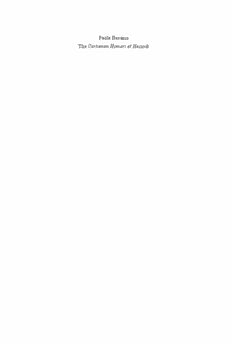Table Of ContentPaola Bassino
The Certamen Homeri et Hesiodi
TEXTE UND KOMMENTARE
Eine altertumswissenschaftliche Reihe
Herausgegeben von
Michael Dewar, Karla Pollmann, Ruth Scodel
Band 59
De Gruyter
The Certamen Homeri et Hesiodi
A Commentary
by
Paola Bassino
De Gruyter
ISBN 978-3-11-058284-0
e-ISBN (PDF) 978-3-11-058477-6
e-ISBN (EPUB) 978-3-11-058348-9
ISSN 0563-3087
Library of Congress Control Number: 2018957798
Bibliografische Information der Deutschen Nationalbibliothek
Die Deutsche Nationalbibliothek verzeichnet diese Publikation in der
Deutschen Nationalbibliografie; detaillierte bibliografische Daten sind im Internet
über http://dnb.dnb.de abrufbar.
© 2019 Walter de Gruyter GmbH, Berlin/Boston
Satz: Michael Peschke, Berlin
Druck und Bindung: CPI books GmbH, Leck
www.degruyter.com
For my family
Acknowledgements
This book is a revised version of my Doctoral dissertation. I would like to
thank the Department of Classics and Ancient History, the Faculty of Arts
and Humanities, and Ustinov College at Durham University for providing
me with financial support during my Ph.D. The final stages of research were
carried out under the aegis of a large interdisciplinary project, directed by
Prof. Barbara Graziosi at Durham University, generously funded by the Eu-
ropean Research Council, and entitled Living Poets: A New Approach to
Ancient Poetry: www.livingpoets.dur.ac.uk.
Prof. Barbara Graziosi has supervised my work with great competence,
patience, and care, for which I will always be grateful to her. My second
supervisor Prof. Johannes Haubold and Prof. Paola Ceccarelli read over
my work and gave immensely useful advice during my Ph.D. Prof. Richard
Hunter and Dr Ivana Petrovic examined my dissertation and offered several
suggestions for improvement, which greatly helped me during the revision
of my work.
I have benefitted from discussing my work with Giovanna Menci, who
also shared with me the drafts of her editio princeps of P.Duk. inv. 665 while
her work was in progress, and with the scholars who took part in the Kyklos
teleconference (Harvard 2012) and the conference Conflict and Consensus
in Early Hexameter Poetry (Durham 2012).
I would also like to thank David Speranzi and Filippomaria Pontani, who
kindly offered comments on drafts of my section on Marcus Musurus, and
with their expertise helped me improve it.
https://doi.org/10.1515/9783110584776 -201
Table of Contents
Acknowledgements ............................................................................... vii
Abbreviations of editions and works of reference ................................ xi
Introduction ........................................................................................... 1
Part 1: The tradition of the contest between Homer and Hesiod .......... 5
1. The origins ................................................................................. 5
Hesiod, Works and Days 648–62 .............................................. 5
[Hesiod], fr. 357 MW ................................................................ 7
2. Ancient scholarship on the Works and Days:
Plutarch and Proclus .................................................................. 10
The scholium to Hesiod’s Works and Days 650–62 .................. 11
Plutarch, Table Talk 674f–675a and Dinner of the Seven Sages
153f–154a .................................................................................. 13
Proclus, Life of Homer 6 ........................................................... 20
3. Second Sophistic: Dio Chrysostom, Philostratus, and Lucian .. 23
Dio Chrysostom, Oration on Kingship 2.7–12 ......................... 24
Philostratus, Heroicus 43.7–10 ................................................. 27
Lucian, True Story 2.20–22 ....................................................... 30
4. Late antique rhetoric: Themistius and Libanius ........................ 34
Themistius, Oration 30.348c–349a ........................................... 34
Libanius, Defence of Socrates 65–6 .......................................... 37
5. The Byzantine age: John Tzetzes and Eustathius ...................... 40
John Tzetzes .............................................................................. 40
Eustathius, Commentary on Homer’s Iliad (I 6, 28–7, 1
van der Valk) ............................................................................. 45
Part 2: Textual tradition ......................................................................... 47
1. Manuscripts ............................................................................... 48
Florence, Biblioteca Medicea Laurenziana, Plut. 56.1 ............. 48
Vienna, Österreichische Nationalbibliothek, Phil. gr. 187 ........ 52
2. Papyri ......................................................................................... 60
P.Petr. I 25 (1) (P.Lond.Lit. 191) ............................................... 60
P.Mich. inv. 2754 ....................................................................... 67
P.Ath.Soc.Pap. inv. M2 ............................................................. 75
P.Freib. 1.1 b (inv. 12) ............................................................... 77
P.Duk. inv. 665 (olim P.Duk. inv. MF75 6) ............................... 80
x Table of Contents
Part 3: Text and translation ................................................................... 83
Part 4: Commentary .............................................................................. 115
Introductory remarks ...................................................................... 115
1. Introduction (1–2); Hesiod’s birthplace (2–6) ........................... 117
2. Homer’s birthplace (7–17) ........................................................ 118
3. Homer’s parents (18–27); Homer’s name (27–32);
Hadrian (32–43) ........................................................................ 123
4. Homer’s and Hesiod’s chronology and genealogy (44–53) ...... 131
5. Homer’s oracle (54–62) ............................................................. 136
6. Introduction to the contest (62–74) ........................................... 139
7. The ‘riddles of the superlative’ (74–89) .................................... 141
8. The reaction to Homer’s performance (90–4);
the ‘insoluble challenge’ (94–101) ............................................. 144
9. The ‘ambiguous propositions’ (102–37) .................................... 147
10. The ‘numerical problem’ (138–48) .......................................... 156
11. The ‘philosophical questions’ (148–75) .................................. 158
12. The ‘finest passages’ (176–204) .............................................. 164
13. The verdict (205–14); Hesiod’s oracle (215–23) ..................... 167
14. Hesiod’s death (224–53) .......................................................... 170
15. Homer’s Thebaid and Epigoni (254–60); the Midas epigram
and the silver cup (260–74) ....................................................... 176
16. Iliad and Odyssey (275–6); Homer in Athens (276–85) .......... 181
17. Homer in Corinth (286–7); Homer in Argos (287–314) ......... 183
18. Homer in Delos (315–21); Homer’s death (321–38) .............. 188
Figures ................................................................................................... 195
Bibliography ......................................................................................... 199
General index ........................................................................................ 215
Index of Greek words ............................................................................ 220
Index of passages .................................................................................. 221

